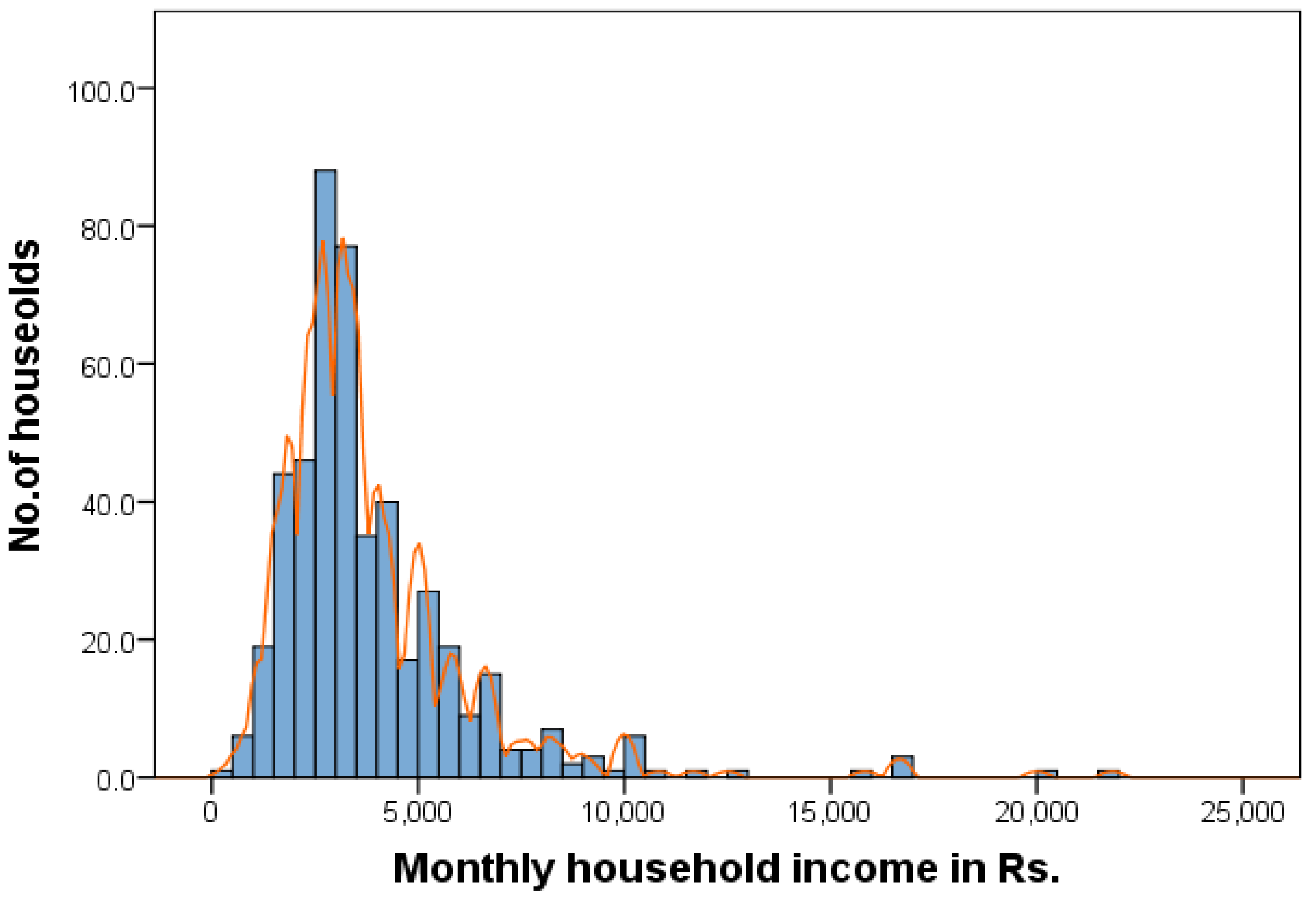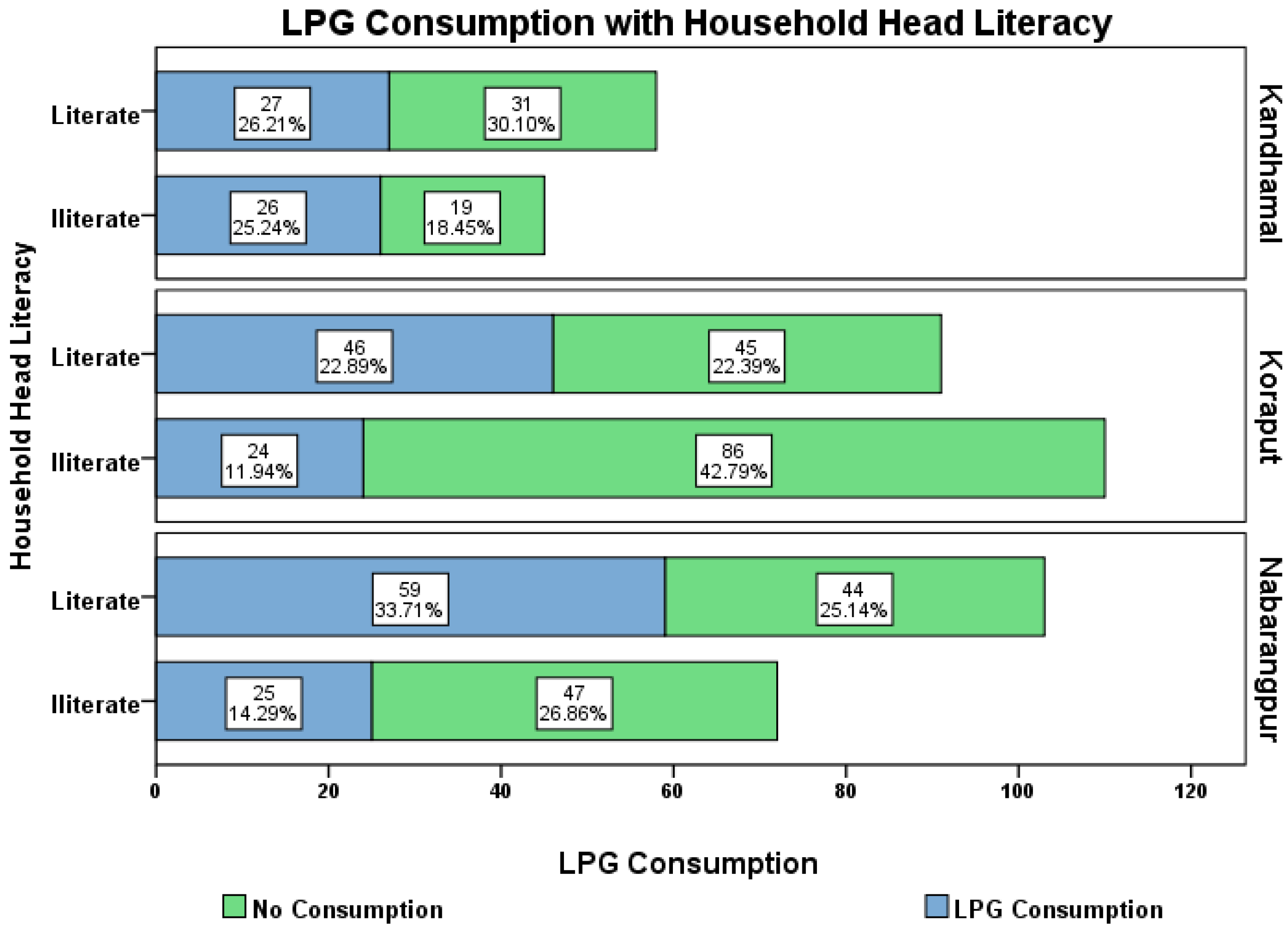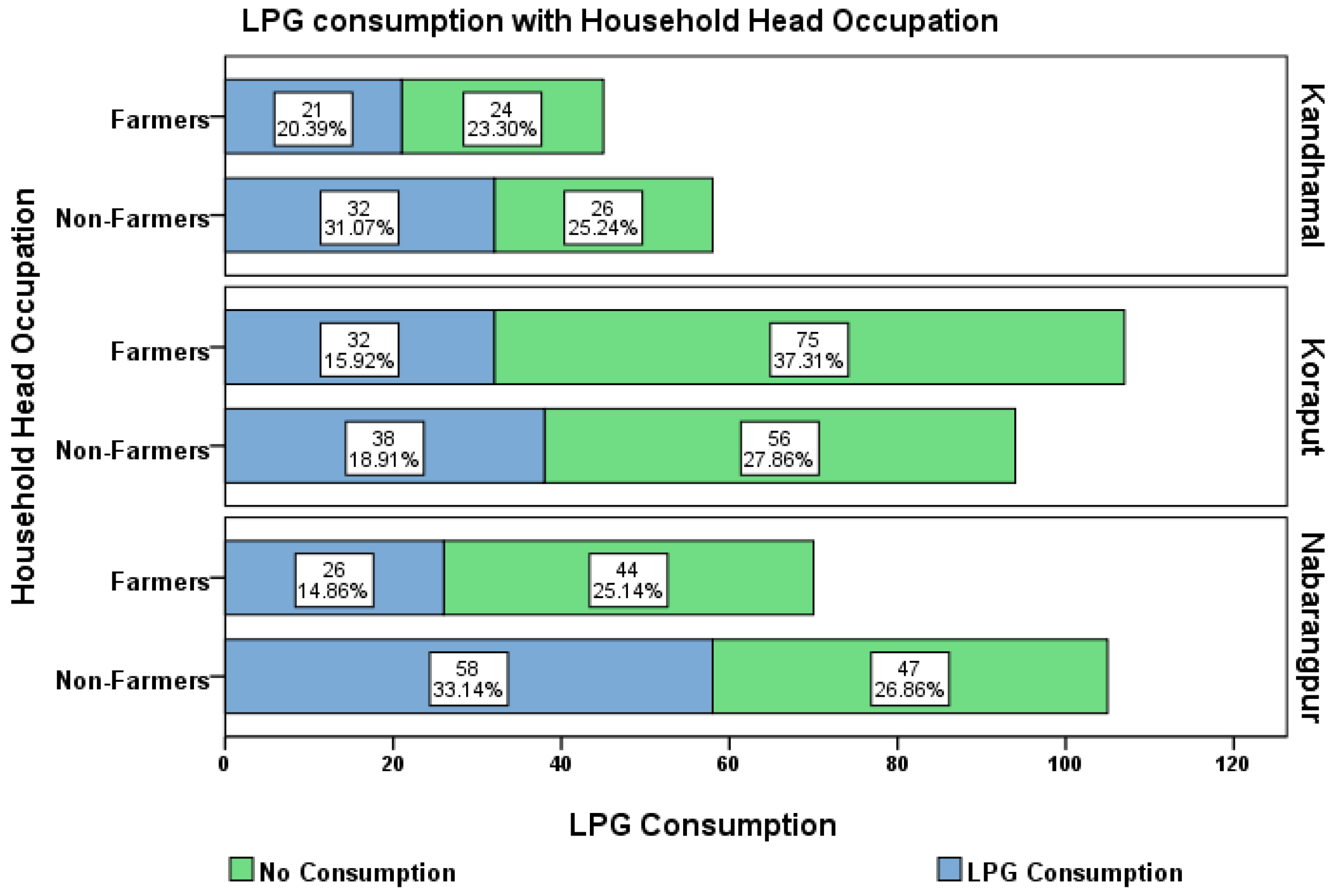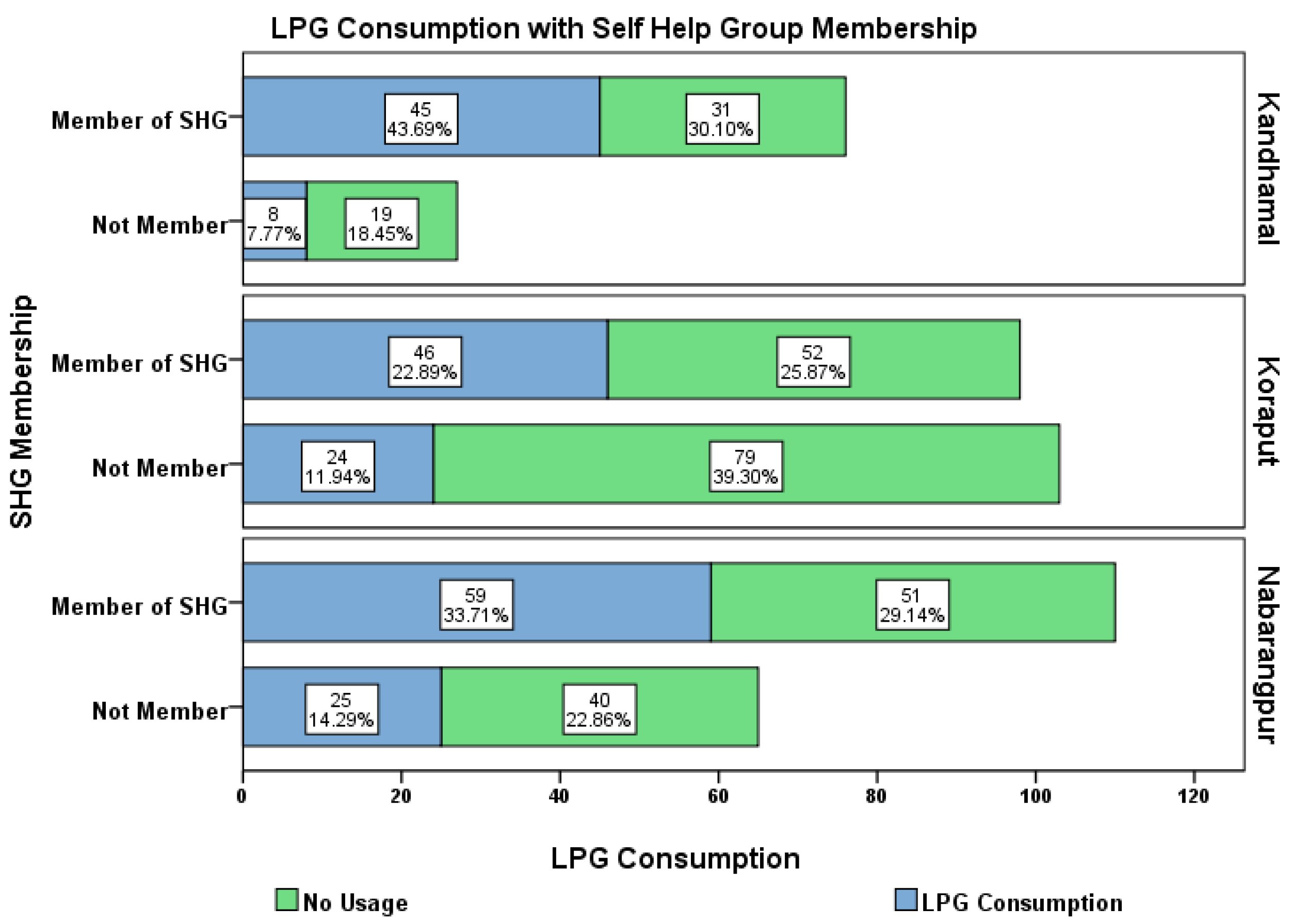Subsidized LPG Scheme and the Shift to Cleaner Household Energy Use: Evidence from a Tribal Community of Eastern India
Abstract
:1. Introduction
2. Theoretical Background
3. Materials and Methods
4. Results and Discussion
4.1. Analyzing the Shortfall between LPG Cylinder Connections and Refills under the PMUY across the States of India
4.2. The Adoption Intensity of Clean Cooking Fuel in the Selected Districts
4.3. Determinants of LPG Adoption under PMUY
5. Conclusions
Author Contributions
Funding
Informed Consent Statement
Data Availability Statement
Acknowledgments
Conflicts of Interest
References
- WEO. Energy Access Outlook 2017: From Poverty to Prosperity; International Energy Agency: Paris, France, 2017. [Google Scholar]
- Baiyegunhi, L.J.S.; Hassan, M.B. Rural household fuel energy transition: Evidence from Giwa LGA Kaduna State, Nigeria. Energy Sustain. Dev. 2014, 20, 30–35. [Google Scholar] [CrossRef]
- Rahut, D.B.; Das, S.; De Groote, H.; Behera, B. Determinants of household energy use in Bhutan. Energy 2014, 69, 661–672. [Google Scholar] [CrossRef]
- Rahut, D.B.; Behera, B.; Ali, A. Factors determining household use of clean and renewable energy sources for lighting in Sub-Saharan Africa. Renew. Sustain. Energy Rev. 2017, 72, 661–672. [Google Scholar] [CrossRef]
- Mensah, J.T.; Adu, G. An empirical analysis of household energy choice in Ghana. Renew. Sustain. Energy Rev. 2015, 51, 1402–1411. [Google Scholar] [CrossRef]
- Lay, J.; Ondraczek, J.; Stoever, J. Renewables in the energy transition: Evidence on solar home systems and lighting fuel choice in Kenya. Energy Econ. 2013, 40, 350–359. [Google Scholar] [CrossRef] [Green Version]
- Chakravorty, S.; Chandrasekhar, S.; Naraparaju, K. Land distribution, income generation and inequality in India’s agricultural sector. Rev. Income Wealth 2019, 65, S182–S203. [Google Scholar] [CrossRef]
- Quinn Ashlinn, K.; Bruce, N.; Puzzolo, E.; Dickinson, K.; Sturke, R.; Jack, D.W.; Mehta, S.; Shankar, A.; Sherr, K.; Rosenthal, J.P. An analysis of efforts to scale up clean household energy for cooking around the world. Energy Sustain. Dev. 2018, 46, 1–10. [Google Scholar] [CrossRef]
- Nakhooda, S. Asia, the multilateral development banks and energy governance. Glob. Policy 2011, 2, 120–132. [Google Scholar] [CrossRef]
- Gangopadhyay, S.; Ramaswami, B.; Wadhwa, W. Reducing subsidies on household fuels in India: How will it affect the poor? Energy Policy 2005, 33, 2326–2336. [Google Scholar] [CrossRef]
- Dabadge, A.; Sreenivas, A.; Josey, A. What has the Pradhan Mantri Ujjwala Yojana achieved so far? Econ. Political Wkly. 2018, 53, 69–75. [Google Scholar]
- Kar, A.; Pachauri, S.; Bailis, R.; Zerriffi, H. Using sales data to assess cooking gas adoption and the impact of India’s Ujjwala programme in rural Karnataka. Nat. Energy 2019, 4, 806–814. [Google Scholar] [CrossRef]
- Masera, O.R.; Saatkamp, B.D.; Kammen, D.M. From linear fuel switching to multiple cooking strategies: A critique and alternative to the energy ladder model. World Dev. 2000, 28, 2083–2103. [Google Scholar] [CrossRef]
- Sharma, A.; Parikh, J.; Singh, C. Transition to LPG for cooking: A case study from two states of India. Energy Sustain. Dev. 2019, 51, 63–72. [Google Scholar] [CrossRef]
- Swain, S.S.; Mishra, P. Determinants of adoption of cleaner cooking energy: Experience of the Pradhan Mantri Ujjwala Yojana in rural Odisha. India. J. Clean. Prod. 2020, 248, 119223. [Google Scholar] [CrossRef]
- Ekholm, T.; Krey, V.; Pachauri, S.; Riahi, K. Determinants of household energy consumption in India. Energy Policy 2010, 38, 5696–5707. [Google Scholar] [CrossRef]
- Rahut, D.B.; Behera, B.; Ali, A. Patterns and determinants of household use of fuels for cooking: Empirical evidence from sub-Saharan Africa. Energy 2016, 117, 93–104. [Google Scholar] [CrossRef]
- Rao, M.N.; Reddy, B.S. Variations in energy use by Indian households: An analysis of micro level data. Energy 2007, 32, 143–153. [Google Scholar] [CrossRef]
- Farsi, M.; Filippini, M.; Pachauri, S. Fuel choices in urban Indian households. Environ. Dev. Econ. 2007, 12, 757–774. [Google Scholar] [CrossRef] [Green Version]
- Guta, D.D. Application of an almost ideal demand system (AIDS) to Ethiopian rural residential energy use: Panel data evidence. Energy Policy 2012, 50, 528–539. [Google Scholar] [CrossRef]
- Lewis, J.J.; Pattanayak, S.K. Who adopts improved fuels and cookstoves? A systematic review. Environ. Health Perspect. 2012, 20, 637–645. [Google Scholar] [CrossRef]
- Pandey, V.L.; Chaubal, A. Comprehending household cooking energy choice in rural India. Biomass Bioenergy 2011, 35, 4724–4731. [Google Scholar] [CrossRef]
- Özcan, K.M.; Gülay, E.; Üçdogruk, S. Economic and demographic determinants of household energy use in Turkey. Energy Policy 2013, 60, 550–557. [Google Scholar] [CrossRef]
- Link, C.F.; Axinn, W.G.; Ghimire, D.J. Household energy consumption: Community context and the fuelwood transition. Soc. Sci. Res. 2012, 41, 598–611. [Google Scholar] [CrossRef] [Green Version]
- Khosla, S.; Jena, P.R. Switch in livelihood strategies and social capital have a role to play in deciding rural poverty dynamics: Evidence from panel data analysis from eastern India. J. Asian Afr. Stud. 2020, 55, 76–94. [Google Scholar] [CrossRef]
- Pachauri, S.; Mueller, A.; Kemmler, A.; Spreng, D. On measuring energy poverty in Indian households. World Dev. 2004, 32, 2083–2104. [Google Scholar] [CrossRef]
- Khandker, S.R.; Barnes, D.F.; Samad, H.A. Are the energy poor also income poor? Evidence from India. Energy Policy 2012, 47, 1–12. [Google Scholar] [CrossRef]
- Behera, B.; Rahut, D.; Jeetendra, A.; Ali, A. Household collection and use of biomass energy sources in South Asia. Energy 2005, 85, 468–480. [Google Scholar] [CrossRef]
- Sadath, A.C.; Acharya, R.H. Assessing the extent and intensity of energy poverty using multidimensional energy poverty index: Empirical evidence from households in India. Energy Policy 2017, 102, 540–550. [Google Scholar] [CrossRef]
- Abhishek, K.; Pachauri, S.; Bailis, R.; Zerriffi, H. Capital cost subsidies through India’s Ujjwala cooking gas programme promote rapid adoption of liquefied petroleum gas but not regular use. Nat. Energy 2020, 5, 125–126. [Google Scholar]
- Patil, R.; Roy, S.; Gore, M.; Ghorpade, M.; Pillarisetti, A.; Chakma, J.; Juvekar, S. Barriers to and facilitators of uptake and sustained use of LPG through the PMUY in tribal communities of Pune district. Energy Sustain. Dev. 2021, 63, 1–6. [Google Scholar] [CrossRef]
- Sidhu, M.K.; Ravindra, K.; Mor, S.; John, S. Household air pollution from various types of rural kitchens and its exposure assessment. Sci. Total Environ. 2017, 586, 419–429. [Google Scholar] [CrossRef] [PubMed]
- Harrell, B.S.; Pillarisetti, A.; Roy, S.; Ghorpade, M.; Patil, R.; Dhongade, A.; Smith, K.R.; Levine, D.I.; Juvekar, S. Incentivizing Elimination of Biomass Cooking Fuels with a Reversible Commitment and a Spare LPG Cylinder. Environ. Sci. Technol. 2020, 54, 5313–15319. [Google Scholar] [CrossRef] [PubMed]
- Malakar, Y.; Day, R. Differences in firewood users’ and LPG users’ perceived relationships between cooking fuels and women’s multidimensional well-being in rural India. Nat. Energy 2020, 5, 1022–1031. [Google Scholar] [CrossRef]







| No. of LPG Connections under PMUY | Year-Wise Increase in Connections under PMUY | ||||||
|---|---|---|---|---|---|---|---|
| State/UT | 2016–2017 | 2017–2018 | 2018–2019 | 2019–2020 | 2017–2018 | 2018–2019 | 2019–2020 |
| Uttar Pradesh | 5.531 | 0.955 | 6.477 | 1.817 | 6.486 | 1.2963 | 14.78 |
| West Bengal | 2.52 | 2.536 | 3.006 | 0.811 | 5.057 | 8.062 | 8.874 |
| Bihar | 2.477 | 2.436 | 2.982 | 0.672 | 4.913 | 7.895 | 8.567 |
| Madhya Pradesh | 2.24 | 1.075 | 3.131 | 0.733 | 3.315 | 6.446 | 7.179 |
| Rajasthan | 1.723 | 0.903 | 3.07 | 0.696 | 2.626 | 5.696 | 6.392 |
| Odisha | 1.012 | 1.288 | 1.926 | 0.523 | 2.3 | 4.226 | 4.749 |
| Maharashtra | 0.859 | 1.019 | 2.186 | 0.373 | 1.877 | 4.064 | 4.436 |
| Jharkhand | 0.537 | 0.667 | 1.701 | 0.385 | 1.204 | 2.905 | 3.29 |
| Tamil Nadu | 0.273 | 0.745 | 2.124 | 0.101 | 1.018 | 3.142 | 3.243 |
| Karnataka | 0.016 | 0.893 | 1.914 | 0.326 | 0.909 | 2.823 | 3.149 |
| Chhattisgarh | 1.105 | 0.847 | 0.741 | 0.306 | 1.952 | 2.693 | 2.998 |
| Gujarat | 0.752 | 0.517 | 1.252 | 0.387 | 1.269 | 2.521 | 2.908 |
| Jammu and Kashmir | 0.266 | 0.107 | 0.68 | 0.177 | 0.373 | 1.053 | 1.23 |
| Punjab | 0.245 | 0.137 | 0.827 | 0.016 | 0.382 | 1.209 | 1.225 |
| Telangana | NA | NA | 0.924 | 0.151 | NA | NA | 1.075 |
| Haryana | 0.279 | 0.078 | 0.323 | 0.051 | 0.357 | 0.68 | 0.731 |
| Uttarakhand | 0.114 | 0.024 | 0.215 | 0.052 | 0.137 | 0.353 | 0.405 |
| Andhra Pradesh | 0.063 | 0.017 | 0.263 | 0.048 | 0.08 | 0.343 | 0.391 |
| Kerala | 0.011 | 0.027 | 0.172 | 0.046 | 0.038 | 0.21 | 0.256 |
| Himachal Pradesh | 0.002 | 0.028 | 0.083 | 0.023 | 0.03 | 0.113 | 0.136 |
| Total No. of Refill Consumption of PMUY Beneficiaries (in Millions) | Average Annual Refill Consumption per PMUY Beneficiary | |||||
|---|---|---|---|---|---|---|
| State/UT | 2017–2018 | 2018–2019 | 2019–2020 | 2017–2018 | 2018–2019 | 2019–2020 |
| Andhra Pradesh | 0.248 | 0.330 | 0.733 | 3.10 | 0.96 | 1.88 |
| Bihar | 14.593 | 12.601 | 14.439 | 2.97 | 1.60 | 1.69 |
| Chhattisgarh | 2.572 | 2.126 | 3.171 | 1.32 | 0.79 | 1.06 |
| Gujarat | 4.340 | 3.993 | 4.432 | 3.42 | 1.58 | 1.52 |
| Haryana | 1.788 | 1.699 | 1.490 | 5.01 | 2.50 | 2.04 |
| Himachal Pradesh | 0.075 | 0.190 | 0.286 | 2.52 | 1.69 | 2.10 |
| Jammu and Kashmir | 0.955 | 1.145 | 1.837 | 2.56 | 1.09 | 1.49 |
| Jharkhand | 2.363 | 3.040 | 4.716 | 1.96 | 1.05 | 1.43 |
| Karnataka | 1.995 | 3.284 | 5.448 | 2.19 | 1.16 | 1.73 |
| Kerala | 0.093 | 0.284 | 0.478 | 2.42 | 1.35 | 1.87 |
| Madhya Pradesh | 6.534 | 6.742 | 9.808 | 1.97 | 1.05 | 1.37 |
| Maharashtra | 4.688 | 5.596 | 7.325 | 2.50 | 1.38 | 1.65 |
| Odisha | 5.229 | 4.895 | 7.726 | 2.27 | 1.16 | 1.63 |
| Punjab | 1.420 | 2.345 | 2.434 | 3.71 | 1.94 | 1.99 |
| Rajasthan | 7.540 | 7.480 | 10.163 | 2.87 | 1.31 | 1.59 |
| Tamil Nadu | 2.390 | 4.905 | 5.829 | 2.35 | 1.56 | 1.80 |
| Telangana | 0.00 | 0.758 | 1.765 | NA | NA | 1.64 |
| Uttar Pradesh | 21.312 | 19.024 | 25.812 | 3.29 | 1.47 | 1.75 |
| Uttarakhand | 0.596 | 0.644 | 0.730 | 4.34 | 1.83 | 1.80 |
| West Bengal | 13.351 | 10.997 | 16.522 | 2.64 | 1.36 | 1.86 |
| Variable | Mean | Std. Dev. | Min | Max |
|---|---|---|---|---|
| Household size in numbers | 4.87 | 2.00 | 1 | 12 |
| HH head’s age in numbers | 43.46 | 14.49 | 18 | 90 |
| HH head’s schooling in Years | 3.32 | 3.87 | 0 | 15 |
| Distance to hospital in kilometers | 9.26 | 8.92 | 0.1 | 35 |
| Spouse’s schooling in years | 1.91 | 3.46 | 0 | 12 |
| Income in Rupees | 3866.02 | 2512.77 | 300 | 21,834 |
| Land in acres | 2.47 | 4.84 | 0 | 35 |
| Explanatory Variables | Coef. | Z-Stat | p-Value |
|---|---|---|---|
| Intercept | −3.487 *** | −3.18 | 0.001 |
| Log monthly income | 0.259 * | 1.8 | 0.072 |
| Age of household | 0.009 * | 1.9 | 0.058 |
| Education of household head (Years) | 0.059 *** | 2.88 | 0.004 |
| HH size | 0.040 | 1.14 | 0.255 |
| Spouse’s education (Years) | 0.017 | 0.78 | 0.435 |
| Type of house | 0.252 *** | 2.56 | 0.01 |
| Separate room for cooking | 0.299 * | 1.82 | 0.069 |
| Occupation | −0.115 | −0.86 | 0.388 |
| Land size | −0.034 ** | −2.22 | 0.027 |
| Member of SHG | 0.400 *** | 2.98 | 0.003 |
| Distance to hospital | −0.037 *** | −4.22 | 0.000 |
| Number of observations | 479 | ||
| Prob > chi2 | 0.000 | ||
| Pseudo R2 | 0.1606 |
| Explanatory Variable | Coef. | Z-Stat | p-Value |
|---|---|---|---|
| Log monthly income | 0.238 ** | 1.9 | 0.068 |
| HH head’s age | 0.012 ** | 2.54 | 0.011 |
| HH head’s schooling | 0.072 *** | 3.92 | 50.000 |
| HH size | 0.032 | 0.96 | 0.338 |
| Spouse’s schooling | 0.012 | 0.61 | 0.540 |
| Type of house | 0.216 ** | 2.36 | 0.018 |
| Separate room for cooking | 0.232 | 1.57 | 0.116 |
| Occupation | −0.131 | −1.07 | 0.285 |
| Land size | −0.03 | −2.09 | 0.036 |
| Member of SHG | 0.384 *** | 3.05 | 0.002 |
| Distance to Hospital | −0.027 *** | −3.34 | 0.001 |
| Number of observations | 479 | ||
| Prob > chi2 | 0.00 | ||
| Pseudo R2 | 0.111 |
| Variable | Coef. (1) | Coef. (2) | Coef. (3) |
|---|---|---|---|
| Log monthly income | −0.093 * (0.050) | 0.023 * (0.012) | 0.070 * (0.039) |
| HH head’s age | −0.005 *** (0.001) | 0.001 ** (0.0005) | 0.003 ** (0.001) |
| HH head’s schooling | −0.028 *** (0.007) | 0.007 *** (0.002) | 0.021 *** (0.005) |
| HH size | −0.012 (0.012) | 0.003 (0.003) | 0.009 (0.009) |
| Spouse’s schooling | −0.005 (0.007) | 0.001 (0.001) | 0.004 (0.005) |
| Type of house | −0.084 (0.035) | 0.021 ** (0.009) | 0.064 ** (0.027) |
| Separate room for cooking | −0.091 (0.585) | 0.020 * (0.011) | 0.072 (0.048) |
| Occupation | 0.051 (0.047) | −0.013 (0.012) | −0.039 (0.036) |
| Land size | 0.012 *** (0.005) | −0.003 ** (0.001) | −0.009 ** (0.004) |
| Member of SHG | −0.148 *** (0.047) | 0.038 *** (0.014) | 0.110 *** (0.034) |
| Distance to Hospital | 0.010 *** (0.003) | −0.003 *** (0.0008) | −0.008 *** (0.002) |
Publisher’s Note: MDPI stays neutral with regard to jurisdictional claims in published maps and institutional affiliations. |
© 2022 by the authors. Licensee MDPI, Basel, Switzerland. This article is an open access article distributed under the terms and conditions of the Creative Commons Attribution (CC BY) license (https://creativecommons.org/licenses/by/4.0/).
Share and Cite
Kalli, R.; Jena, P.R.; Managi, S. Subsidized LPG Scheme and the Shift to Cleaner Household Energy Use: Evidence from a Tribal Community of Eastern India. Sustainability 2022, 14, 2450. https://doi.org/10.3390/su14042450
Kalli R, Jena PR, Managi S. Subsidized LPG Scheme and the Shift to Cleaner Household Energy Use: Evidence from a Tribal Community of Eastern India. Sustainability. 2022; 14(4):2450. https://doi.org/10.3390/su14042450
Chicago/Turabian StyleKalli, Rajesh, Pradyot Ranjan Jena, and Shunsuke Managi. 2022. "Subsidized LPG Scheme and the Shift to Cleaner Household Energy Use: Evidence from a Tribal Community of Eastern India" Sustainability 14, no. 4: 2450. https://doi.org/10.3390/su14042450
APA StyleKalli, R., Jena, P. R., & Managi, S. (2022). Subsidized LPG Scheme and the Shift to Cleaner Household Energy Use: Evidence from a Tribal Community of Eastern India. Sustainability, 14(4), 2450. https://doi.org/10.3390/su14042450






